Circular Economy Development in the Wood Construction Sector in Finland
Abstract
1. Introduction
2. Materials and Methods
3. Results
3.1. The Importance of the CE Concept as a Part of Building Design and Construction
3.2. The Familiarity of CE Aspects in the Construction Sector
3.3. The Importance of the Main CE Principles in the Built Environment
3.4. The Importance of CE Aspects in the Design of Wooden Buildings
3.5. The Importance of CE Aspects Related to Wood Materials, Components and Products
3.6. The Importance of CE Aspects in the Wood Construction Sector
3.7. The Importance of Approaches to Integrate CE into Wood Construction
3.8. The Use or Introduction of Approaches to Promote CE in the Design of Wooden Buildings
3.9. The Importance of Aspects Related to Cascading Use of Wood for Wood Construction
3.10. The Importance of Aspects Related to CE Ecosystems in the Wood Construction Sector
3.11. The Importance of CE Business Models and Associated Aspects in the Wood Construction Sector
3.12. The Importance of Approaches to Assess CE Performance in the Wood Construction Sector
3.13. The Use or Introduction of Approaches to Promote CE of Wood Construction
4. Conclusions
Author Contributions
Funding
Institutional Review Board Statement
Informed Consent Statement
Data Availability Statement
Conflicts of Interest
References
- Ellen McArthur Foundation. Towards a Circular Economy: Business Rationale for an Accelerated Transition. Available online: https://ellenmacarthurfoundation.org/towards-a-circular-economy-business-rationale-for-an-accelerated-transition (accessed on 6 January 2023).
- Rodríguez, J.; Rubio, L.; Celemín-Pedroche, M.; Alonso-Almeida, M. Analysis of the relations between circular economy and sustainable development goals. Int. J. Sustain. Dev. World Ecol. 2019, 26, 1–13. [Google Scholar] [CrossRef]
- Finnish Government. Uusi Suunta: Ehdotus Kiertotalouden Strategiseksi Ohjelmaksi. Publications of the Finnish Government 2021:1. Available online: https://julkaisut.valtioneuvosto.fi/handle/10024/162654 (accessed on 10 January 2023).
- Lerwen, L.; Ramakrishna, S. Introduction and overview. In An Introduction to Circular Economy, 1st ed.; Lerwen, L., Ramakrishna, S., Eds.; Springer: Singapore, 2021; pp. 1–16. [Google Scholar]
- Balkenende, R.; Bocken, N.; Bakker, C. Design for the circular economy. In Routledge Handbook of Sustainable Design; Egenhoefer, R.B., Ed.; Taylor & Francis Group: Abingdon, UK; New York, NY, USA, 2017; pp. 498–513. ISBN 9781138650176. [Google Scholar]
- Larsen, V.G.; Tollin, N.; Sattrup, P.A.; Birkved, M.; Holmboe, T. What are the challenges in assessing circular economy for the built environment? A literature review on integrating LCA, LCC and S-LCA in life cycle sustainability assessment, LCSA. J. Build. Eng. 2022, 50, 104203. [Google Scholar] [CrossRef]
- Giorgi, S.; Lavagna, M.; Wang, K.; Osmani, M.; Liu, G.; Campioli, A. Drivers and barriers towards circular economy in the building sector: Stakeholder interviews and analysis of five European countries policies and practices. J. Clean. Prod. 2022, 336, 130395. [Google Scholar] [CrossRef]
- Hasheminasab, H.; Zolfani, S.H.; Kharrazi, M.; Streimikiene, D. Combination of sustainability and circular economy to develop a cleaner building industry. Energy Build. 2022, 258, 111838. [Google Scholar] [CrossRef]
- Eberhardt, L.C.M.; van Stijn, A.; Kristensen Stranddorf, L.; Birkved, M.; Birgisdottir, H. Environmental Design Guidelines for Circular Building Components: The Case of the Circular Building Structure. Sustainability 2021, 13, 5621. [Google Scholar] [CrossRef]
- Eberhardt, L.C.M.; Rønholt, J.; Birkved, M.; Birgisdottir, H. Circular Economy potential within the building stock—Mapping the embodied greenhouse gas emissions of four Danish examples. J. Build. Eng. 2021, 33, 101845. [Google Scholar] [CrossRef]
- Hjaltadóttir, R.E.; Hild, P. Circular Economy in the building industry European policy and local practices. Eur. Plan. Stud. 2021, 29, 2226–2251. [Google Scholar] [CrossRef]
- Benachio, G.L.F.; Freitas, M.C.D.; Tavares, S.F. Circular economy in the construction industry: A systematic literature review. J. Clean. Prod. 2020, 260, 121046. [Google Scholar] [CrossRef]
- Bilal, M.; Khan, K.I.A.; Thaheem, M.J.; Nasir, A.R. Current state and barriers to the circular economy in the building sector: Towards a mitigation framework. J. Clean. Prod. 2020, 276, 123250. [Google Scholar] [CrossRef]
- Munaro, M.R.; Tavares, S.F.; Bragança, L. Towards circular and more sustainable buildings: A systematic literature review on the circular economy in the built environment. J. Clean. Prod. 2020, 260, 121134. [Google Scholar] [CrossRef]
- Lacy, P.; Rutqvist, J. Waste to Wealth: The Circular Economy Advantage; Palgrave Macmillan: London, UK, 2015. [Google Scholar] [CrossRef]
- Mengmeng, C. Key concepts and terminology. In An Introduction to Circular Economy, 1st ed.; Lerwen, L., Ramakrishna, S., Eds.; Springer: Singapore, 2021; pp. 17–34. [Google Scholar]
- Ellen MacArthur Foundation, Stiftungsfonds für Umweltökonomie und Nachhaltigkeit (SUN), Deutsche Post Foundation, McKinsey Center for Business and Environment. Growth within: A Circular Economy Vision for a Competitive Europe. Available online: https://ellenmacarthurfoundation.org/growth-within-a-circular-economy-vision-for-a-competitive-europe (accessed on 8 January 2023).
- Stahel, W.R. Circular economy. Nature 2016, 531, 435–438. [Google Scholar] [CrossRef]
- Prime Minister’s Office Finland. Circular Economy in Finland—Operational Environment, Policy Instruments and Modelled Impacts by 2030. Available online: https://vnk.fi/julkaisu?pubid=11902 (accessed on 7 January 2023).
- Ministry of the Environment. Valtioneuvoston Periaatepäätös Kiertotalouden Strategisesta Ohjelmasta. Publications of the Finnish Government 2021:1. Available online: https://valtioneuvosto.fi/paatokset/paatos?decisionId=0900908f8071a6e1 (accessed on 8 January 2023).
- Ellen MacArthur Foundation. The business opportunity of a circular economy. In An Introduction to Circular Economy, 1st ed.; Lerwen, L., Ramakrishna, S., Eds.; Springer: Singapore, 2021; pp. 397–417. [Google Scholar]
- Marconi, M.; Favi, C. Eco-design teaching initiative within a manufacturing company based on LCA analysis of company product portfolio. J. Clean. Prod. 2020, 242, 118424. [Google Scholar] [CrossRef]
- Spreafico, C.; Landi, D. Using Product Design Strategies to Implement Circular Economy: Differences between Students and Professional Designers. Sustainability 2022, 14, 1122. [Google Scholar] [CrossRef]
- Ipsen, K.L.; Pizzol, M.; Birkved, M.; Amor, B. How Lack of Knowledge and Tools Hinders the Eco-Design of Buildings—A Systematic Review. Urban Sci. 2021, 5, 20. [Google Scholar] [CrossRef]
- Spreafico, C.; Landi, D. Investigating students’ eco-misperceptions in applying eco-design methods. J. Clean. Prod. 2022, 342, 130866. [Google Scholar] [CrossRef]
- Bocken, N.M.P.; de Pauw, I.; Bakker, C.; van der Grinten, B. Product design and business model strategies for a circular economy. J. Ind. Prod. Eng. 2016, 33, 308–320. [Google Scholar] [CrossRef]
- den Hollander, M.C.; Bakker, C.A.; Hultink, E.J. Product Design in a Circular Economy: Development of a Typology of Key Concepts and Terms: Key Concepts and Terms for Circular Product Design. J. Ind. Ecol. 2017, 21, 3. [Google Scholar] [CrossRef]
- Communication from the Commission to the European Parliament, the European Council, the Council, the European Economic and Social Committee and the Committee of the Regions. The European Green Deal. COM/2019/640 Final. Available online: https://eur-lex.europa.eu/legal-content/EN/TXT/?uri=COM%3A2019%3A640%3AFIN (accessed on 11 February 2023).
- Communication from the Commission to the European Parliament, the Council, the Council, the European Economic and Social Committee and the Committee of the Regions. A New Circular Economy Action Plan for a Cleaner and More Competitive Europe. COM/2020/98 Final. Available online: https://eur-lex.europa.eu/legal-content/EN/TXT/?qid=1583933814386&uri=COM:2020:98:FIN (accessed on 17 February 2023).
- Besserer, A.; Troilo, S.; Girods, P.; Rogaume, Y.; Brosse, N. Cascading Recycling of Wood Waste: A Review. Polymers 2021, 13, 1752. [Google Scholar] [CrossRef]
- The Finnish Environment Institute. Biomassan Kaskadiperiaate ja Muut Politiikkatoimet. Synergiat ja Ristiriidat. Suomen Ympäristökeskuksen Raportteja 27/2017.. Available online: http://hdl.handle.net/10138/224563 (accessed on 1 March 2023).
- Mair, C.; Stern, T. Cascading Utilization of Wood: A Matter of Circular Economy? Curr. For. Rep. 2017, 3, 281–295. [Google Scholar] [CrossRef]
- Vis, M.; Mantau, U.; Allen, B. (Eds.) Study on the Optimised Cascading Use of Wood. No 394/PP/ENT/RCH/14/7689. Final Report. Brussels 2016. Available online: https://ec.europa.eu/docsroom/documents/18081/attachments/1/translations/en/renditions/native (accessed on 11 March 2023).
- Mapping Study of Cascading Use of Wood Products. WWF Technical Report. Available online: https://wwfeu.awsassets.panda.org/downloads/wwf_mondi_cascading_use_of_wood_final_web.pdf (accessed on 11 February 2023).
- Sokka, L.; Koponen, K.; Keränen, J.T. Cascading Use of Wood in Finland—With Comparison to Selected EU Countries. VTT Research Report. Available online: https://www.vttresearch.com/sites/default/files/julkaisut/muut/2015/VTT-R-03979-15.pdf (accessed on 12 February 2023).
- Mantau, U. Wood flow analysis: Quantification of resource potentials, cascades and carbon effects. Biomass Bioenergy 2015, 79, 28–38. [Google Scholar] [CrossRef]
- Höglmeier, K.; Weber-Blaschke, G.; Richter, K. Potentials for cascading of recovered wood from building deconstruction—A case study for South-East Germany. Resour. Conserv. Recycl. 2013, 78, 81–91. [Google Scholar] [CrossRef]
- Sirkin, T.; ten Houten, M. The cascade chain: A theory and tool for achieving resource sustainability with application for product design. Resour. Conserv. Recycl. 1994, 10, 213–276. [Google Scholar] [CrossRef]
- Communication from the Commission to the European Parliament, the European Council, the Council, the European Economic and Social Committee and the Committee of the Regions. New European Bauhaus Beautiful, Sustainable, Together. COM/2021/573 Final. Available online: https://eur-lex.europa.eu/legal-content/EN/TXT/?uri=CELEX:52021DC0573 (accessed on 20 February 2023).
- Communication from the Commission to the European Parliament, the Council, the Council, the European Economic and Social Committee and the Committee of the Regions. New EU Forest Strategy for 2030. COM/2021/572 Final. Available online: https://eur-lex.europa.eu/legal-content/EN/TXT/?uri=CELEX:52021DC0572 (accessed on 17 March 2023).
- Saldana, J. Fundamentals of Qualitative Research; Oxford University Press: Oxford, UK, 2011; pp. 3–30, ISBN-10: 0199737959. [Google Scholar]
- Patten, M.L. Questionnaire Research: A Practical Guide, 4th ed.; Routledge: New York, NY, USA, 2014. [Google Scholar] [CrossRef]
- Gillham, B. Developing a Questionnaire, 2nd ed.; Continuum International Publishing Group: London, UK, 2007; ISBN-10: 0826496318. [Google Scholar]
- Hirsjärvi, H.; Remes, P.; Sajavaara, P. Tutki ja Kirjoita, 13th ed.; Tammi: Helsinki, Finland, 2007; ISBN 978-951-26-5635-6. [Google Scholar]
- Birmingham, P.; Wilkinson, D. Using Research Instruments: A Guide for Researchers; Taylor & Francis Group: London, UK, 2003; ISBN 9780415272797. [Google Scholar]
- Fink, A. How to Conduct Surveys: A Step-by-Step Guide, 4th ed.; Sage: Southend Oaks, CA, USA, 2009; ISBN-10: 141296668X. [Google Scholar]
- Oppenheim, A.N. Questionnaire Design, Interviewing and Attitude Measurement; Pinter: London, UK; Washington, DC, USA, 1997; ISBN-10: 0826451764. [Google Scholar]
- Saris, W.E.; Gallhofer, I.N. Design, Evaluation, and Analysis of Questionnaires for Survey Research; John Wiley & Sons: Hoboken, NJ, USA, 2007; ISBN-10: 0470114959. [Google Scholar]
- Sudman, S.; Bradbrun, N.M. Asking Questions: A Practical Guide to Questionnaire Design. The Jossey-Bass Series in Social and Behavioural Sciences; Jossey-Bass Publishers: Hoboken, NJ, USA, 1982; ISBN 9780985895464. [Google Scholar]
- Peterson, R.A. Constructing Effective Questionnaires; SAGE Publications: Thousand Oaks, CA, USA, 2000. [Google Scholar] [CrossRef]
- Eberhardt, L.C.M.; Birkved, M.; Birgisdottir, H. Building Design and Construction Strategies for a Circular Economy. Archit. Eng. Des. Manag. 2022, 18, 93–113. [Google Scholar] [CrossRef]
- Othman, A.A.E.; AlNassar, N. A Framework for Achieving Sustainability by Overcoming the Challenges of the Construction Supply Chain during the Design Process. Organ. Technol. Manag. Constr. 2021, 13, 2391–2415. [Google Scholar] [CrossRef]
- Ogunmakinde, O.E.; Egbelakin, T.; Sher, W. Contributions of the circular economy to the UN sustainable development goals through sustainable construction. Resour. Conserv. Recycl. 2022, 178. [Google Scholar] [CrossRef]
- Li, R.Y.M.; Meng, L.; Leung, T.H.; Zuo, J.; Tang, B.; Wang, Y. Unmaking waste in construction in the EU and the Asian circular economy: A formal institutional approach. In Unmaking Waste in Production and Consumption: Towards the Circular Economy, 1st ed.; Crocker, R., Saint, C., Chen, G., Tong, Y., Eds.; Emerald Publishing Limited: Bingley, UK, 2018; pp. 225–240. ISBN 9781787146204. [Google Scholar]
- Norouzi, M.; Chàfer, M.; Cabeza, L.F.; Jiménez, L.; Boer, D. Circular economy in the building and construction sector: A scientific evolution analysis. J. Build. Eng. 2021, 44, 102704. [Google Scholar] [CrossRef]
- Kanters, J. Circular Building Design: An Analysis of Barriers and Drivers for a Circular Building Sector. Buildings 2020, 10, 77. [Google Scholar] [CrossRef]
- Gagnon, B.; Tanguay, X.; Amor, B.; Imbrogno, A.F. Forest Products and Circular Economy Strategies: A Canadian Perspective. Energies 2022, 15, 673. [Google Scholar] [CrossRef]
- Guerra, B.C.; Leite, F. Circular economy in the construction industry: An overview of United States stakeholders’ awareness, major challenges, and enablers. Resour. Conserv. Recycl. 2021, 170, 105617. [Google Scholar] [CrossRef]
- Minunno, R.; O’Grady, T.; Morrison, G.M.; Gruner, R.L.; Colling, M. Strategies for Applying the Circular Economy to Prefabricated Buildings. Buildings 2018, 8, 125. [Google Scholar] [CrossRef]
- Alhosnia, I.S.; Amoudib, O.; Callaghan, N. Circular economy during project life cycle. In Circular Economy and Sustainability, Management and Policy; Stefanakis, A., Nikolaou, I., Eds.; Elsevier: Amsterdam, The Netherlands, 2021; Volume 1, pp. 177–188. ISBN 978-0-12-819817-9. [Google Scholar]
- Hoosain, M.S.; Paul, B.S.; Raza, S.M.; Ramakrishna, S. Material passports and circular economy. In An Introduction to Circular Economy, 1st ed.; Lerwen, L., Ramakrishna, S., Eds.; Springer: Singapore, 2021; pp. 131–158. [Google Scholar]
- Brummelhuis, A.; Marinelli, T. How circular design at signify brings economic, environmental, and social value. In Circular Economy and Sustainability, Management and Policy; Stefanakis, A., Nikolaou, I., Eds.; Elsevier: Amsterdam, The Netherlands, 2021; Volume 1, pp. 335–345. ISBN 978-0-12-819817-9. [Google Scholar]
- Van Doorsselaer, K. The role of ecodesign in the circular economy. In Circular Economy and Sustainability, Management and Policy; Stefanakis, A., Nikolaou, I., Eds.; Elsevier: Amsterdam, The Netherlands, 2021; Volume 1, pp. 189–205. ISBN 978-0-12-819817-9. [Google Scholar]
- Roberts, M.; Allen, S.; Coley, D. Life cycle assessment in the building design process—A systematic literature review. Build. Environ. 2020, 185, 107274. [Google Scholar] [CrossRef]
- Husgafvel, R.; Sakaguchi, D. Circular Economy Development in the Construction Sector in Japan. World 2022, 3, 1–26. [Google Scholar] [CrossRef]
- Husgafvel, R.; Linkosalmi, L.; Sakaguchi, D.; Hughes, M. Company perspectives on sustainable circular economy development in the South Karelia and Kymenlaakso regions and in the publishing sector in Finland. In Circular Economy and Sustainability, Management and Policy; Stefanakis, A., Nikolaou, I., Eds.; Elsevier: Amsterdam, The Netherlands, 2021; Volume 1, pp. 619–649. ISBN 978-0-12-819817-9. [Google Scholar]
- Husgafvel, R.; Linkosalmi, L.; Hughes, M.; Kanerva, J.; Dahl, O. Forest sector circular economy in Finland: A regional study on sustainability driven competitive advantage and an assessment of the potential for cascading recovered solid wood. J. Clean. Prod. 2018, 181, 483–497. [Google Scholar] [CrossRef]
- Husgafvel, R.; Linkosalmi, L.; Dahl, O. Company perspectives on the development of the circular economy in the seafaring sector and the Kainuu region in Finland. J. Clean. Prod. 2018, 186, 673–681. [Google Scholar] [CrossRef]
- Husgafvel, R.; Watkins, G.; Linkosalmi, L.; Dahl, O. Review of sustainability management initiatives within Finnish forest products companies—Translating EU level steering into proactive initiatives. Resour. Conserv. Recycl. 2013, 76, 1–11. [Google Scholar] [CrossRef]
- Carcassi, O.B.; De Angelis, E.; Iannaccone, G.; Malighetti, L.E.; Masera, G.; Pittau, F. Bio-based materials for the Italian construction industry: Buildings as carbon sponges. In Regeneration of the Built Environment from a Circular Economy Perspective, 1st ed.; Della Torre, S., Cattaneo, S., Lenzi, C., Zanelli, A., Eds.; Springer International Publishing: Cham, Switzerland, 2020; pp. 237–247. [Google Scholar]
- Campioli, A.; Mussinelli, E.; Lavagna, M.; Tartaglia, A. Design strategies and LCA of alternative solutions for resilient, circular, and zero-carbon urban regeneration: A case study. In Regeneration of the Built Environment from a Circular Economy Perspective, 1st ed.; Della Torre, S., Cattaneo, S., Lenzi, C., Zanelli, A., Eds.; Springer International Publishing: Cham, Switzerland, 2020; pp. 205–215. [Google Scholar]
- Niu, Y.; Rasi, K.; Hughes, M.; Halme, M.; Fink, G. Prolonging life cycles of construction materials and combating climate change by cascading: The case of reusing timber in Finland. Resour. Conserv. Recycl. 2021, 170, 105555. [Google Scholar] [CrossRef]
- Vis, M.; Reumerman, P.; Gärtner, S. Cascading in the Wood Sector. Technical Report, Netherlands Enterprise Agency (RVO). 2014. Available online: https://www.rvo.nl/sites/default/files/2014/11/cascading-wood-sector-final-report-btg.pdf (accessed on 15 March 2023).
- Suter, F.; Steubing, B.; Hellweg, S. Life cycle impacts and benefits of wood along the value chain: The case of Switzerland. J. Ind. Ecol. 2017, 21, 874–886. [Google Scholar] [CrossRef]
- Husgafvel, R.; Linkosalmi, L.; Sakaguchi, D.; Hughes, M. How to advance sustainable and circular economy oriented public procurement?—A review of the operational environment and a case study from the Kymenlaakso region in Finland. In Circular Economy and Sustainability, Management and Policy; Stefanakis, A., Nikolaou, I., Eds.; Elsevier: Amsterdam, The Netherlands, 2021; Volume 1, pp. 227–277. ISBN 978-0-12-819817-9. [Google Scholar]
- Heeren, N.; Mutel, C.L.; Steubing, B.; Ostermeyer, Y.; Wallbaum, H.; Hellweg, S. Environmental Impact of Buildings—What Matters? Environ. Sci. Technol. 2015, 49, 9832–9841. [Google Scholar] [CrossRef]
- Hildebrandt, J.; Hagemann, N.; Thrän, D. The contribution of wood-based construction materials for leveraging a low carbon building sector in Europe. Sustain. Cities Soc. 2017, 34, 405–418. [Google Scholar] [CrossRef]
- Ottelin, J.; Amiri, A.; Steubing, B.; Junnila, S. Comparative carbon footprint analysis of residents of wooden and non-wooden houses in finland. Environ. Res. Lett. 2021, 16, 74006. [Google Scholar] [CrossRef]
- Häyrinen, L.; Toppinen, A.; Toivonen, R. Finnish young adults’ perceptions of the health, well-being and sustainability of wooden interior materials. Scand. J. For. Res. 2020, 35, 394–402. [Google Scholar] [CrossRef]
- Brunet-Navarro, P.; Jochheim, H.; Kroiher, F.; Muys, B. Effect of cascade use on the carbon balance of the German and European wood sectors. J. Clean. Prod. 2018, 170, 137–146. [Google Scholar] [CrossRef]
- Toppinen, A.; Röhr, A.; Pätäri, S.; Lähtinen, K.; Toivonen, R. The future of wooden multistory construction in the forest bioeconomy—A Delphi study from Finland and Sweden. J. For. Econ. 2018, 31, 3–10. [Google Scholar] [CrossRef]
- Miller, A.; Ip, K. Sustainable construction materials. In Design and Management of Sustainable Built Environments; Yao, R., Ed.; Springer: London, UK, 2013; pp. 341–358. [Google Scholar] [CrossRef]
- Asdrubali, F.; Ferracuti, B.; Lombardi, L.; Guattari, C.; Evangelisti, L.; Grazieschi, G. A review of structural, thermo-physical, acoustical, and environmental properties of wooden materials for building applications. Build. Environ. 2017, 114, 307–332. [Google Scholar] [CrossRef]
- Balasbaneh, A.T.; Marsono, A.K.B.; Khaleghi, S.J. Sustainability choice of different hybrid timber structure for low medium cost single-story residential building: Environmental, economic and social assessment. J. Build. Eng. 2018, 20, 235–247. [Google Scholar] [CrossRef]
- Riala, M.; Ilola, L. Multi-storey timber construction and bioeconomy—Barriers and opportunities. Scand. J. For. Res. 2014, 29, 367–377. [Google Scholar] [CrossRef]
- Leising, E.; Quist, J.; Bocken, N. Circular Economy in the building sector: Three cases and a collaboration tool. J. Clean. Prod. 2018, 176, 976–989. [Google Scholar] [CrossRef]
- Antonini, E.; Boeri, A.; Giglio, F. Beyond emergency towards circular design: Building low tech. In Emergency Driven Innovation: Low Tech Buildings and Circular Design, 1st ed.; Springer: Cham, Switzerland, 2020; pp. 59–86. [Google Scholar]
- Antonini, E.; Boeri, A.; Giglio, F. Assessing the circular potential: Design, build, living reversible. In Emergency Driven Innovation: Low Tech Buildings and Circular Design, 1st ed.; Springer: Cham, Switzerland, 2020; pp. 87–152. [Google Scholar]
- Antonini, E.; Boeri, A.; Giglio, F. Building strategies for circular economy: New visions and knowledge production for European research. In Emergency Driven Innovation: Low Tech Buildings and Circular Design, 1st ed.; Springer: Cham, Switzerland, 2020; pp. 153–172. [Google Scholar]
- Høibye, L.; Sand, H. Circular Economy in the Nordic Construction Sector. Identification and Assessment of Potential Policy Instruments that Can Accelerate a Transition toward a Circular Economy. Available online: https://norden.diva-portal.org/smash/get/diva2:1188884/FULLTEXT01.pdf (accessed on 18 February 2023).
- Giorgi, S.; Lavagna, M.; Campioli, A. Circular economy and regeneration of building stock: Policy improvements, stakeholder networking and life cycle tools. In Regeneration of the Built Environment from a Circular Economy Perspective, 1st ed.; Della Torre, S., Cattaneo, S., Lenzi, C., Zanelli, A., Eds.; Springer International Publishing: Cham, Switzerland, 2020; pp. 291–301. [Google Scholar]
- Markström, E.; Kuzman, M.K.; Bystedt, A.; Sandberg, D.; Fredriksson, M. Swedish architects view of engineered wood products in buildings. J. Clean. Prod. 2018, 181, 33–41. [Google Scholar] [CrossRef]
- Roos, A.; Woxblom, L.; McCluskey, D. The influence of architects and structural engineers on timber in construction—Perceptions and roles. Silva Fenn. 2010, 44, 126. [Google Scholar] [CrossRef]
- Markström, E.; Kuzman, M.K.; Bystedt, A.; Sandberg, D. Use of wood products in multi-storey residential buildings: Views of Swedish actors and suggested measures for an increased use. Wood Mater. Sci. Eng. 2019, 14, 404–419. [Google Scholar] [CrossRef]
- Sakaguchi, D.; Takano, A.; Hughes, M. The potential for cascading wood from demolished buildings: Potential flows and possible applications through a case study in Finland. Int. Wood Prod. J. 2017, 8, 208–215. [Google Scholar] [CrossRef]
- Akinade, O.; Oyedele, L.; Oyedele, A.; Delgado, J.M.D.; Bilal, M.; Akanbi, L.; Ajayi, A.; Owolabi, H. Design for deconstruction using a circular economy approach: Barriers and strategies for improvement. Prod. Plan. Control. 2020, 31, 829–840. [Google Scholar] [CrossRef]
- Fraanje, P.J. Cascading of pine wood. Resour. Conserv. Recycl. 1997, 19, 21–28. [Google Scholar] [CrossRef]
- Sakaguchi, D.; Takano, A.; Hughes, M. The potential for cascading wood from demolished buildings: The condition of recovered wood through a case study in Finland. Int. Wood Prod. J. 2016, 7, 137–143. [Google Scholar] [CrossRef]
- Bais-Moleman, A.L.; Sikkema, R.; Vis, M.; Reumerman, P.; Theurl, M.C.; Erb, K.-H. Assessing wood use efficiency and greenhouse gas emissions of wood product cascading in the European Union. J. Clean. Prod. 2018, 172, 3942–3954. [Google Scholar] [CrossRef]
- Mehr, J.; Vadenbo, C.; Steubing, B.; Hellweg, S. Environmentally optimal wood use in Switzerland—Investigating the relevance of material cascades. Resour. Conserv. Recycl. 2018, 131, 181–191. [Google Scholar] [CrossRef]
- Nasiri, B.; Piccardo, C.; Hughes, M. Estimating the material stock in residential houses in Finland. Waste Manag. 2021, 135, 318–326. [Google Scholar] [CrossRef]
- Cascading Recovered Wood (CaReWood). WoodWisdom-Net Research Programme Final Report. Available online: https://forestvalue.org/wp-content/uploads/2018/07/wwnet_jc4_final_reporting_CaReWood.pdf (accessed on 9 February 2023).
- Höglmeier, K.; Steubing, B.; Weber-Blaschke, G.; Richter, K. LCA-based optimization of wood utilization under special consideration of a cascading use of wood. J. Environ. Manag. 2015, 152, 158–170. [Google Scholar] [CrossRef]
- Szichta, P.; Risse, M.; Weber-Blaschke, G.; Richter, K. Potentials for wood cascading: A model for the prediction of the recovery of timber in Germany. Resour. Conserv. Recycl. 2022, 178, 106101. [Google Scholar] [CrossRef]
- Sathre, R.; Gustavsson, L. Energy and carbon balances of wood cascade chains. Resour. Conserv. Recycl. 2006, 47, 332–355. [Google Scholar] [CrossRef]
- Jarre, M.; Petit-Boix, A.; Priefer, C.; Meyer, R.; Leipold, S. Transforming the bio-based sector towards a circular economy—What can we learn from wood cascading? For. Policy Econ. 2020, 110, 101872. [Google Scholar] [CrossRef]
- Haberl, H.; Geissler, S. Cascade utilization of biomass: Strategies for a more efficient use of a scarce resource. Ecol. Eng. 2000, 16, 111–121. [Google Scholar] [CrossRef]
- Höglmeier, K.; Weber-Blaschke, G.; Richter, K. Utilization of Recovered Wood in Cascades versus Utilization of Primary Wood—A Comparison with Life Cycle Assessment Using System Expansion. Int. J. Life Cycle Assess. 2014, 19, 1755–1766. [Google Scholar] [CrossRef]
- Campbell-Johnston, K.; Vermeulen, W.J.V.; Reike, D.; Brullot, S. The circular economy and cascading: Towards a framework. Resour. Conserv. Recycl. 2020, 7, 100038. [Google Scholar] [CrossRef]
- Höglmeier, K.; Weber-Blaschke, G.; Richter, K. Evaluation of wood cascading. In Sustainability Assessment of Renewables-Based Products: Methods and Case Studies; Dewulf, J., de Meester, S., Alvarenga, R.A.F., Eds.; John Wiley & Sons, Ltd.: Chichester, UK, 2015; pp. 335–346. ISBN 9781118933947. [Google Scholar]
- Thonemann, N.; Schumann, M. Environmental impacts of wood-based products under consideration of cascade utilization: A systematic literature review. J. Clean. Prod. 2018, 172, 4181–4188. [Google Scholar] [CrossRef]
- Viholainen, N.; Kylkilahti, E.; Autio, M.; Pöyhönen, J.; Toppinen, A. Bringing ecosystem thinking to sustainability-driven wooden construction business. J. Clean. Prod. 2021, 292, 126029. [Google Scholar] [CrossRef]
- Augiseau, V. Circular Economy and Construction. Circular Economy: From Waste Reduction to Value Creation. Volume 3; Delchet-Cochet, K., Ed.; ISTE: London, UK; John Wiley & Sons: Hoboken, NJ, USA, 2020; pp. 139–158. ISBN 978-1-78630-573-2. [Google Scholar]
- Potting, J.; Hekkert, M.P.; Worrell, E.; Hanemaaijer, A. Circular Economy: Measuring Innovation in the Product Chain; PBL Netherlands Environmental Assessment Agency: The Hague, The Netherlands, 2017. [Google Scholar]
- Toppinen, A.; Miilumäki, N.; Vihemäki, H.; Toivonen, R.; Lähtinen, K. Collaboration and shared logic for creating value-added in three Finnish wooden multi-storey building projects. Wood Mater. Sci. Eng. 2019, 14, 269–279. [Google Scholar] [CrossRef]
- Schroeder, P.; Anggraeni, K.; Weber, U. The Relevance of Circular Economy Practices to the Sustainable Development Goals. J. Ind. Ecol. 2019, 23, 77–95. [Google Scholar] [CrossRef]
- Narayan, R.; Tidström, A. Circular economy inspired imaginaries for sustainable innovations. In Innovation for Sustainability: Business Transformations towards a Better World; Bocken, N., Ritala, P., Albareda, L., Verburg, R., Eds.; Springer: Cham, Switzerland, 2019; pp. 393–413. [Google Scholar]
- Reike, D.; Vermeulen, W.J.V.; Witjes, S. The circular economy: New or Refurbished as CE 3.0?—Exploring Controversies in the Conceptualization of the Circular Economy through a Focus on History and Resource Value Retention Options. Resour. Conserv. Recycl. 2018, 135, 246–264. [Google Scholar] [CrossRef]
- Guldmann, E.; Huulgaard, R.D. Circular business model innovation for sustainable development. In Innovation for Sustainability: Business Transformations towards a Better World; Bocken, N., Ritala, P., Albareda, L., Verburg, R., Eds.; Springer: Cham, Switzerland, 2019; pp. 77–95. [Google Scholar]
- Ortiz, O.; Castells, F.; Sonnemann, G. Sustainability in the construction industry: A review of recent developments based on LCA. Constr. Build. Mater. 2009, 23, 28–39. [Google Scholar] [CrossRef]
- Buyle, M.; Galle, W.; Debacker, W.; Audenaert, A. Sustainability assessment of circular building alternatives: Consequential LCA and LCC for internal wall assemblies as a case study in a Belgian context. J. Clean. Prod. 2019, 218, 141–156. [Google Scholar] [CrossRef]
- Gheewala, S.H.; Silalertruksa, T. Life cycle thinking in a circular economy. In An Introduction to Circular Economy, 1st ed.; Lerwen, L., Ramakrishna, S., Eds.; Springer: Singapore, 2021; pp. 35–53. [Google Scholar]
- Crafford, P.L.; Wessels, C.B.; Blumentritt, M. Sustainability and wood constructions: A review of green building rating systems and life-cycle assessment methods from a South African and developing world perspective. Adv. Build. Energy Res. 2021, 15, 67–86. [Google Scholar] [CrossRef]
- Lützkendorf, T. Assessing the environmental performance of buildings: Trends, lessons and tensions. Build. Res. Inf. 2018, 46, 594–614. [Google Scholar] [CrossRef]
- Pero, M.; Moretto, A.; Bottani, E.; Bigliardi, B. Environmental Collaboration for Sustainability in the Construction Industry: An Exploratory Study in Italy. Sustainability 2017, 9, 125. [Google Scholar] [CrossRef]
- Franzini, F.; Berghall, S.; Toppinen, A.; Toivonen, R. Comparing wood versus concrete: An explorative study of municipal civil servants’ beliefs about multistory building materials in Finland. For. Prod. J. 2021, 71, 65–76. [Google Scholar] [CrossRef]
- Harju, C. The Perceived Quality of Wooden Building materials—A Systematic Literature Review and Future Research Agenda. Int. J. Consum. Stud. 2022, 46, 29–55. [Google Scholar] [CrossRef]
- Lähtinen, K.; Harju, C.; Toppinen, A. Consumers’ perceptions on the properties of wood affecting their willingness to live in and prejudices against houses made of timber. Wood Mater. Sci. Eng. 2019, 14, 325–331. [Google Scholar] [CrossRef]
- Gosselin, A.; Blanchet, P.; Lehoux, N.; Cimon, Y. Main motivations and barriers for using wood in multi-story and nonresidential construction projects. BioResources 2016, 12, 546–570. [Google Scholar] [CrossRef]
- Viholainen, N.; Kylkilahti, E.; Autio, M.; Toppinen, A. A Home Made of Wood: Consumer Experiences of Wooden Building Materials. Int. J. Consum. Stud. 2020, 44, 542–551. [Google Scholar] [CrossRef]
- Franzini, F.; Toivonen, R.; Toppinen, A. Why Not Wood? Benefits and Barriers of Wood as a Multistory Construction Material: Perceptions of Municipal Civil Servants from Finland. Buildings 2018, 8, 159. [Google Scholar] [CrossRef]
- Lazarevic, D.; Kautto, P.; Antikainen, R. Finland’s wood-frame multi-storey construction innovation system: Analysing motors of creative destruction. For. Policy Econ. 2020, 110, 101861. [Google Scholar] [CrossRef]

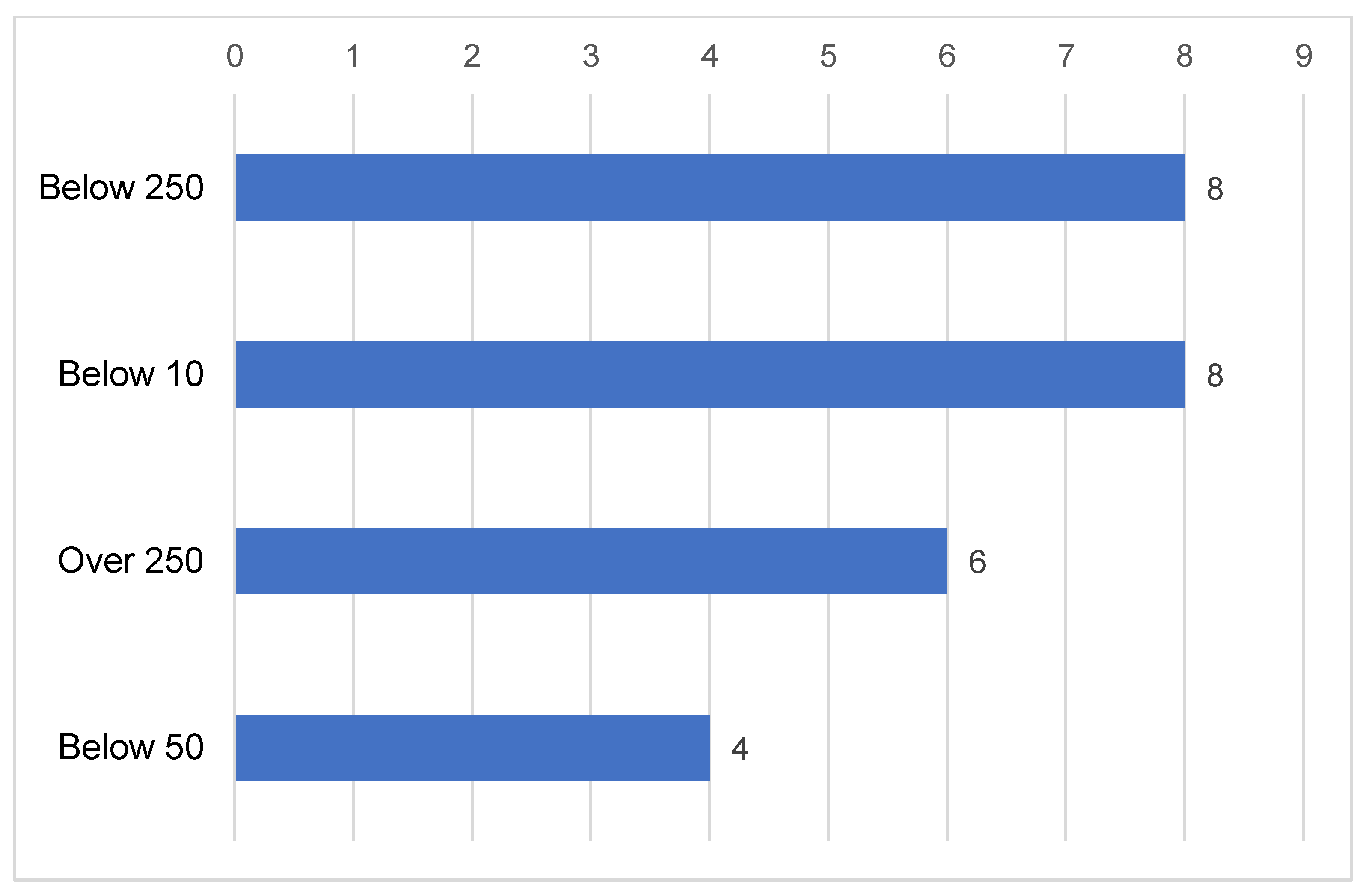
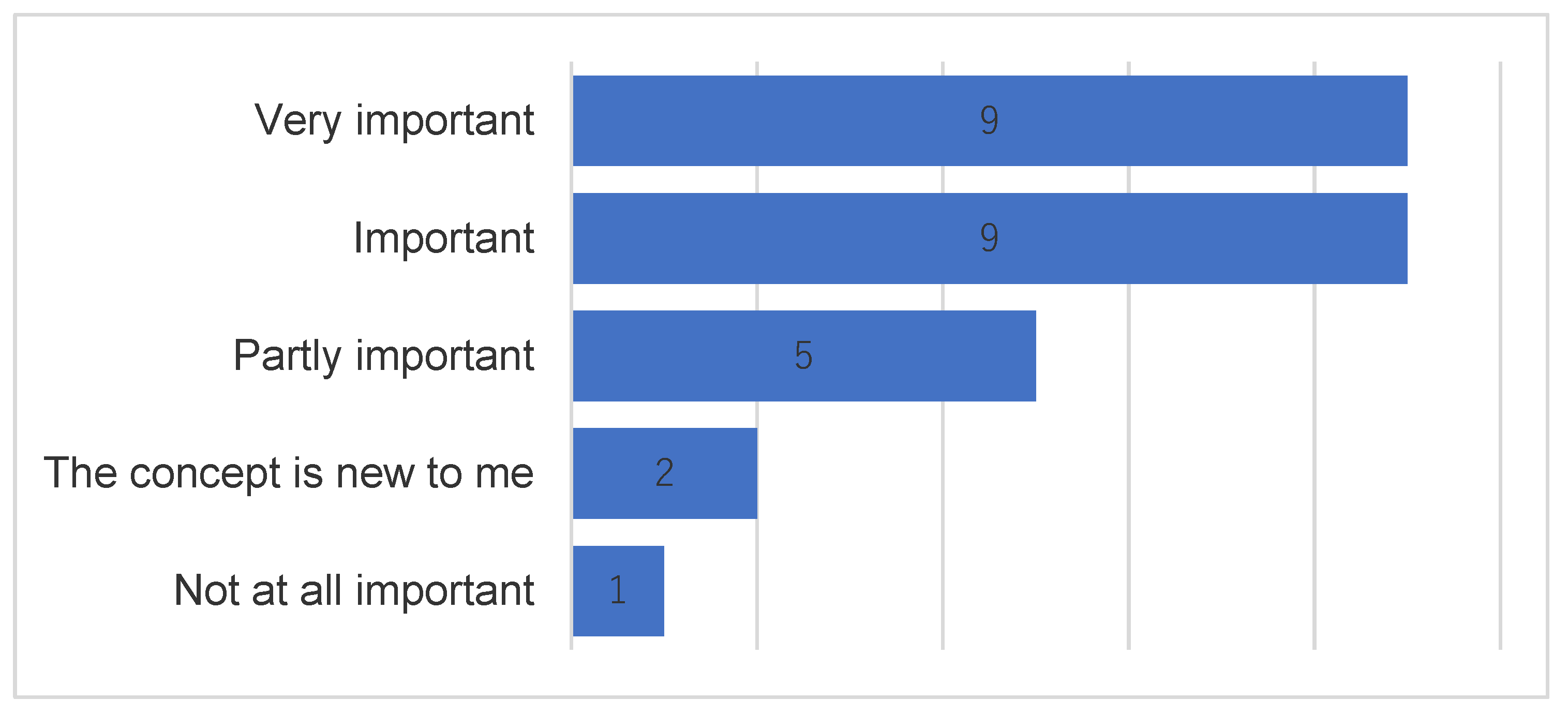
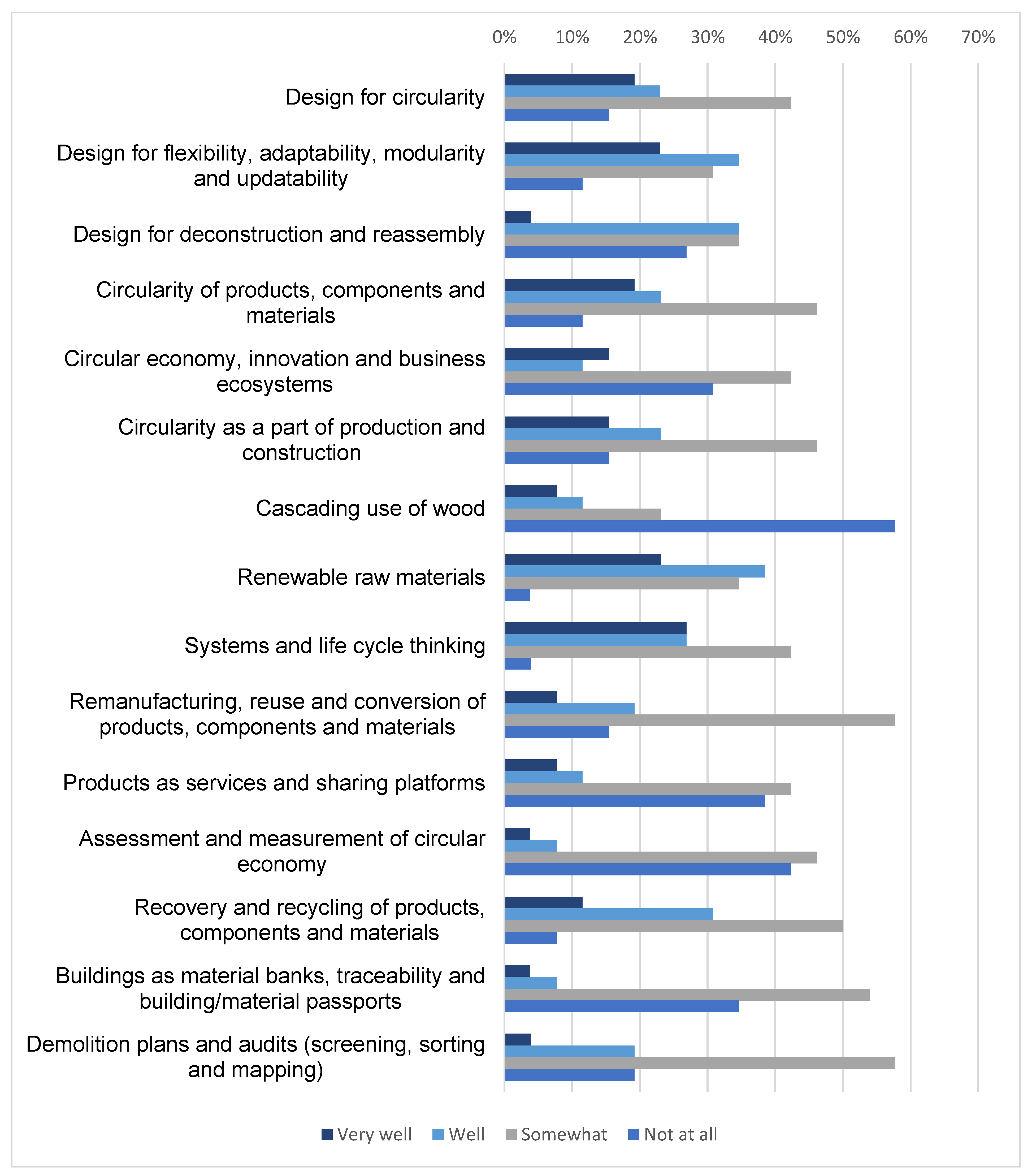


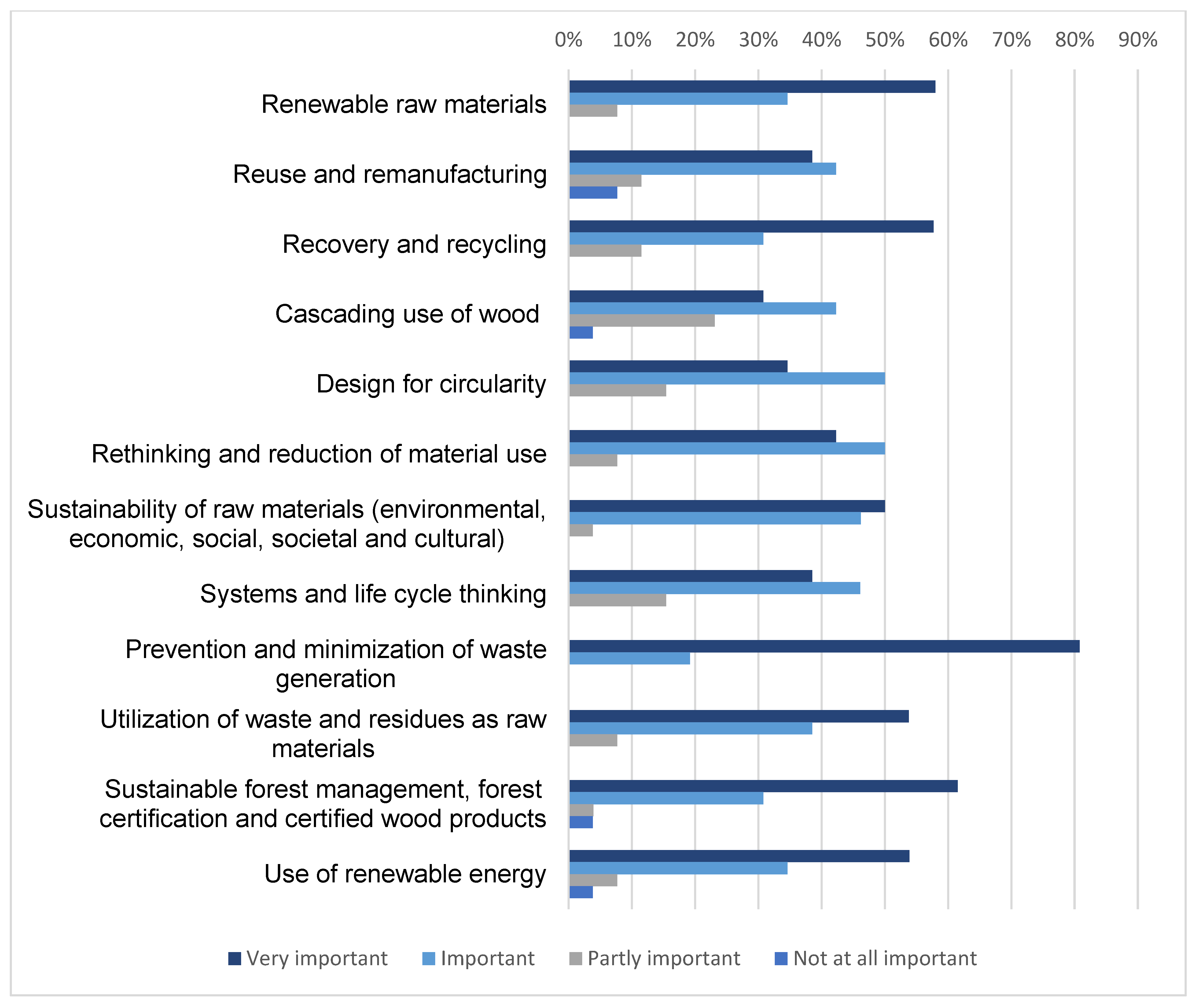
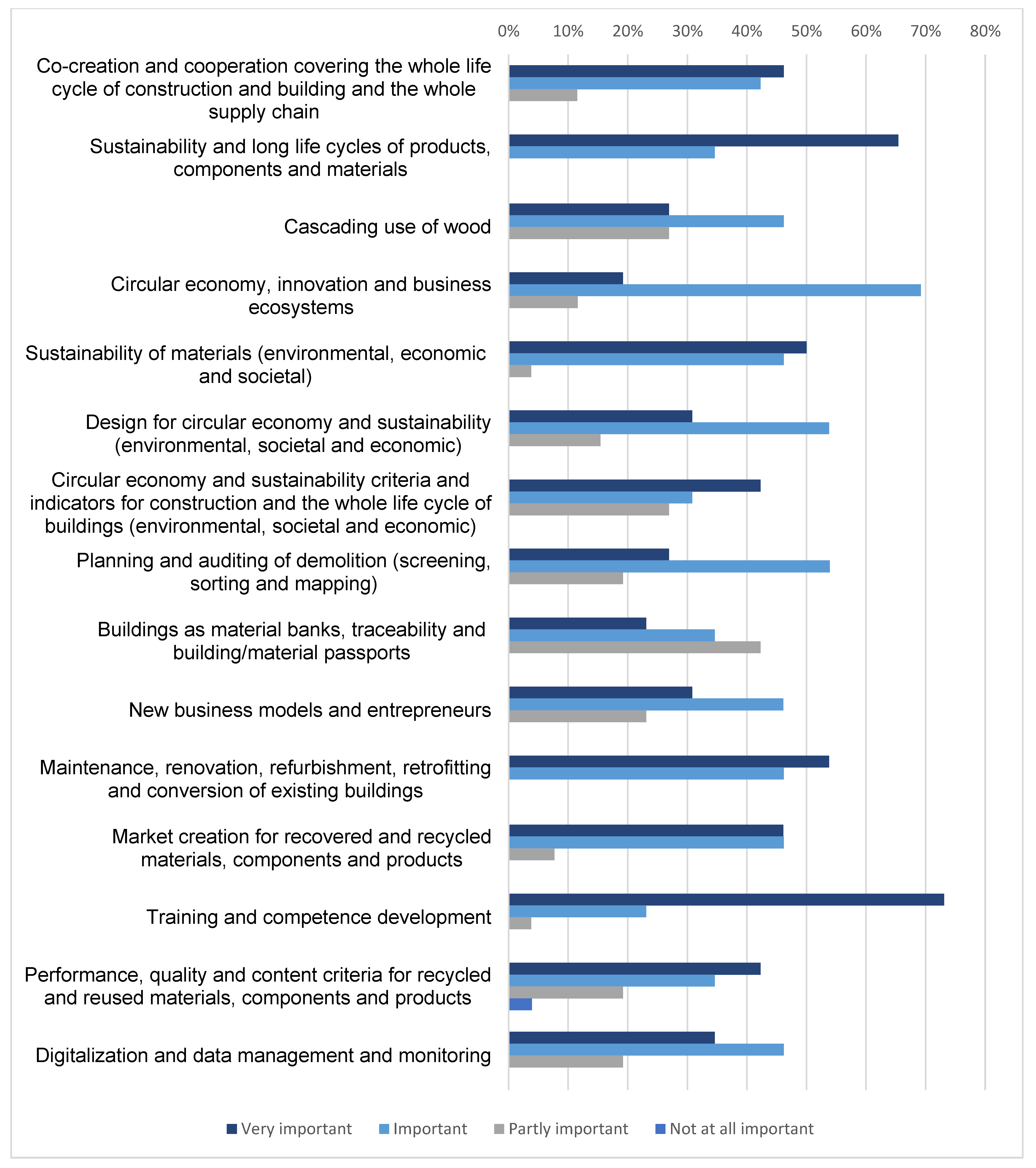
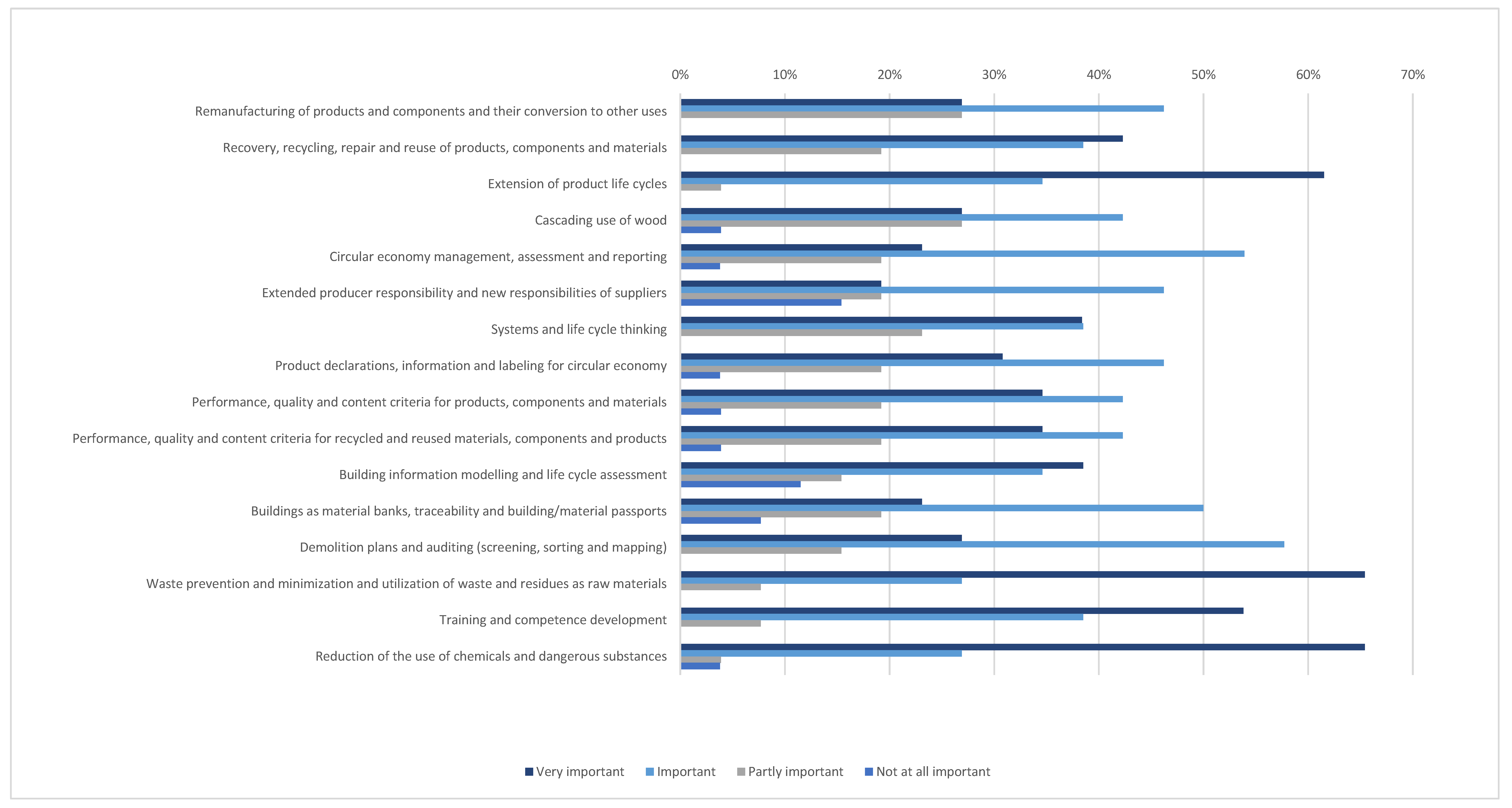

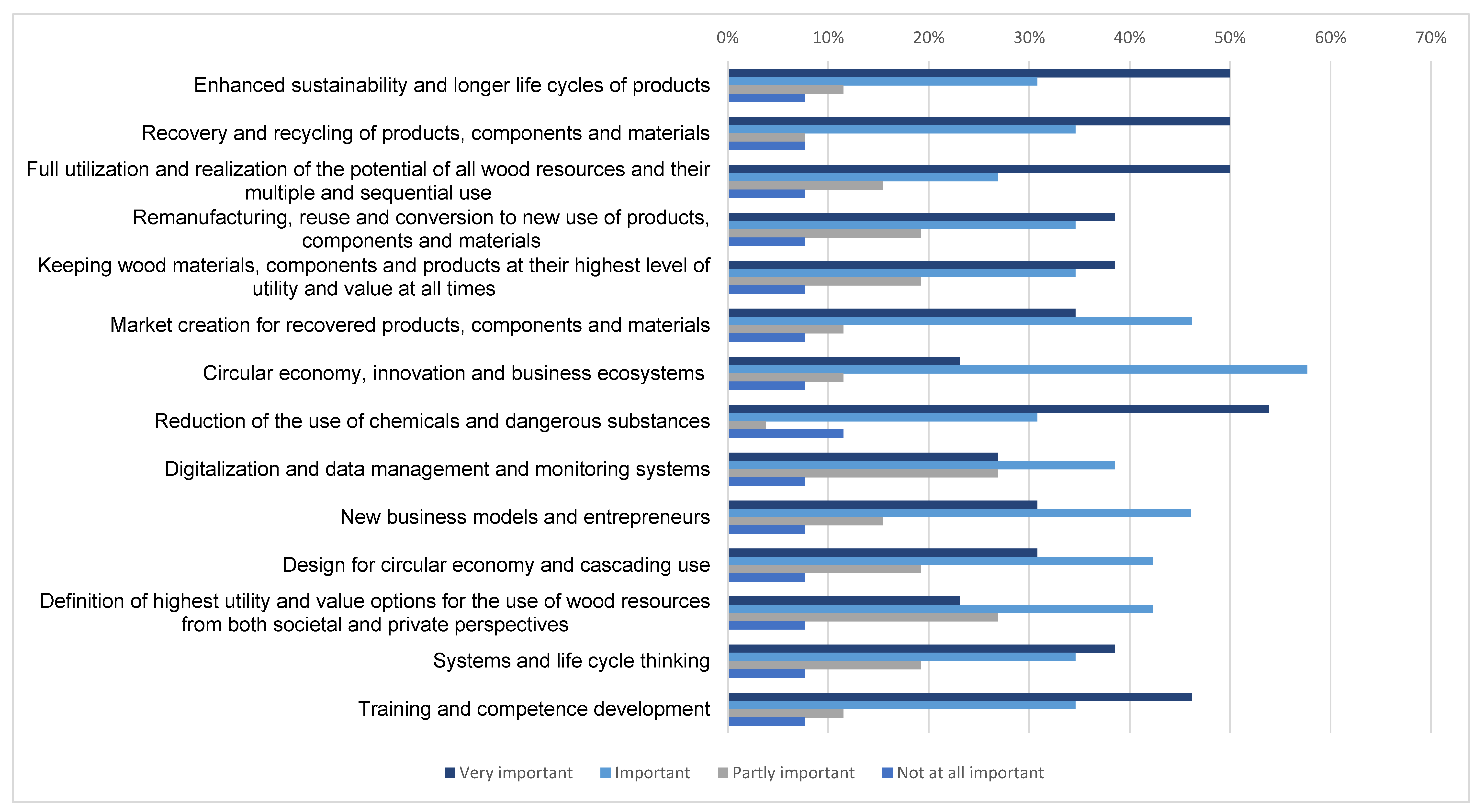

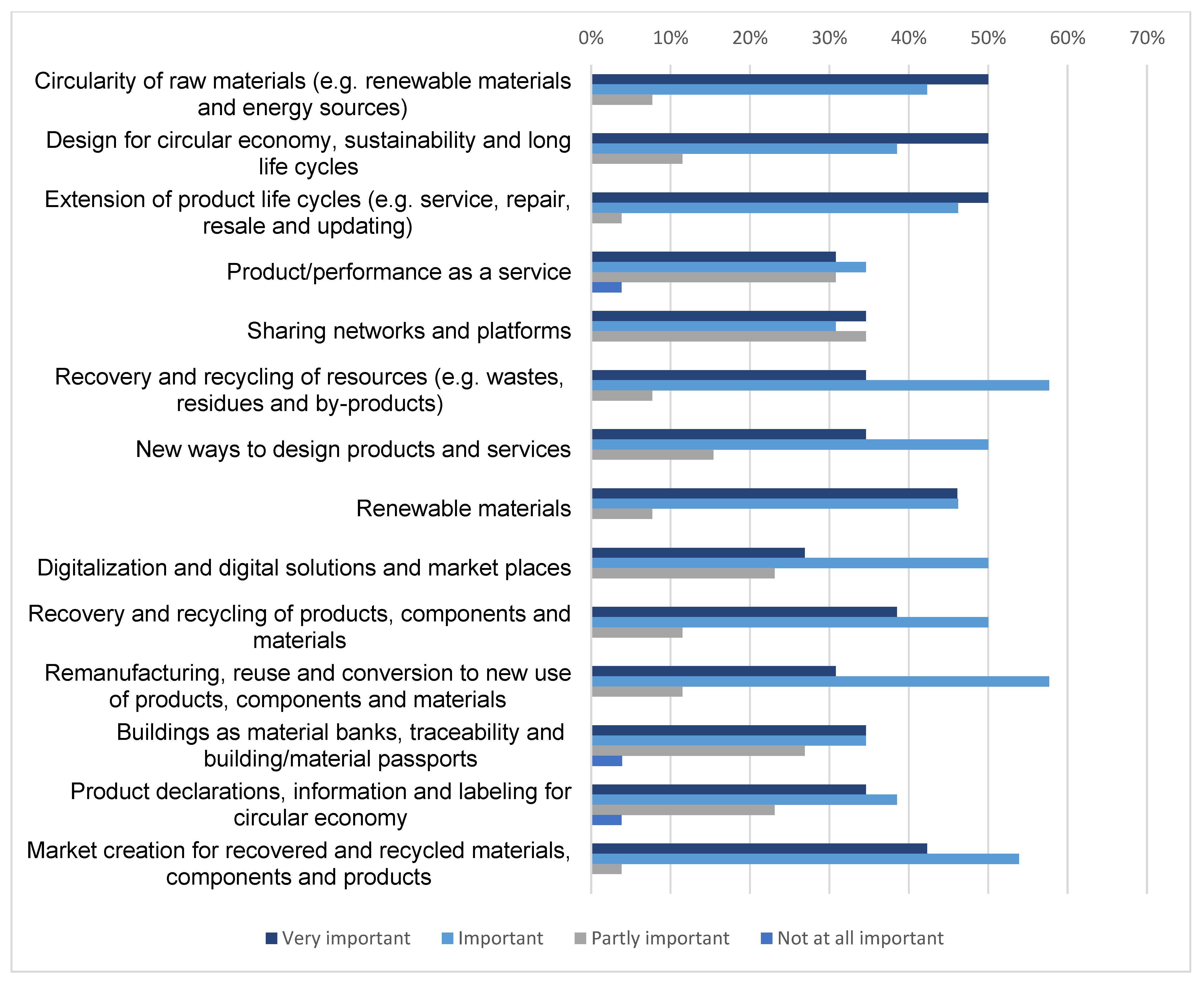


Disclaimer/Publisher’s Note: The statements, opinions and data contained in all publications are solely those of the individual author(s) and contributor(s) and not of MDPI and/or the editor(s). MDPI and/or the editor(s) disclaim responsibility for any injury to people or property resulting from any ideas, methods, instructions or products referred to in the content. |
© 2023 by the authors. Licensee MDPI, Basel, Switzerland. This article is an open access article distributed under the terms and conditions of the Creative Commons Attribution (CC BY) license (https://creativecommons.org/licenses/by/4.0/).
Share and Cite
Husgafvel, R.; Sakaguchi, D. Circular Economy Development in the Wood Construction Sector in Finland. Sustainability 2023, 15, 7871. https://doi.org/10.3390/su15107871
Husgafvel R, Sakaguchi D. Circular Economy Development in the Wood Construction Sector in Finland. Sustainability. 2023; 15(10):7871. https://doi.org/10.3390/su15107871
Chicago/Turabian StyleHusgafvel, Roope, and Daishi Sakaguchi. 2023. "Circular Economy Development in the Wood Construction Sector in Finland" Sustainability 15, no. 10: 7871. https://doi.org/10.3390/su15107871
APA StyleHusgafvel, R., & Sakaguchi, D. (2023). Circular Economy Development in the Wood Construction Sector in Finland. Sustainability, 15(10), 7871. https://doi.org/10.3390/su15107871






